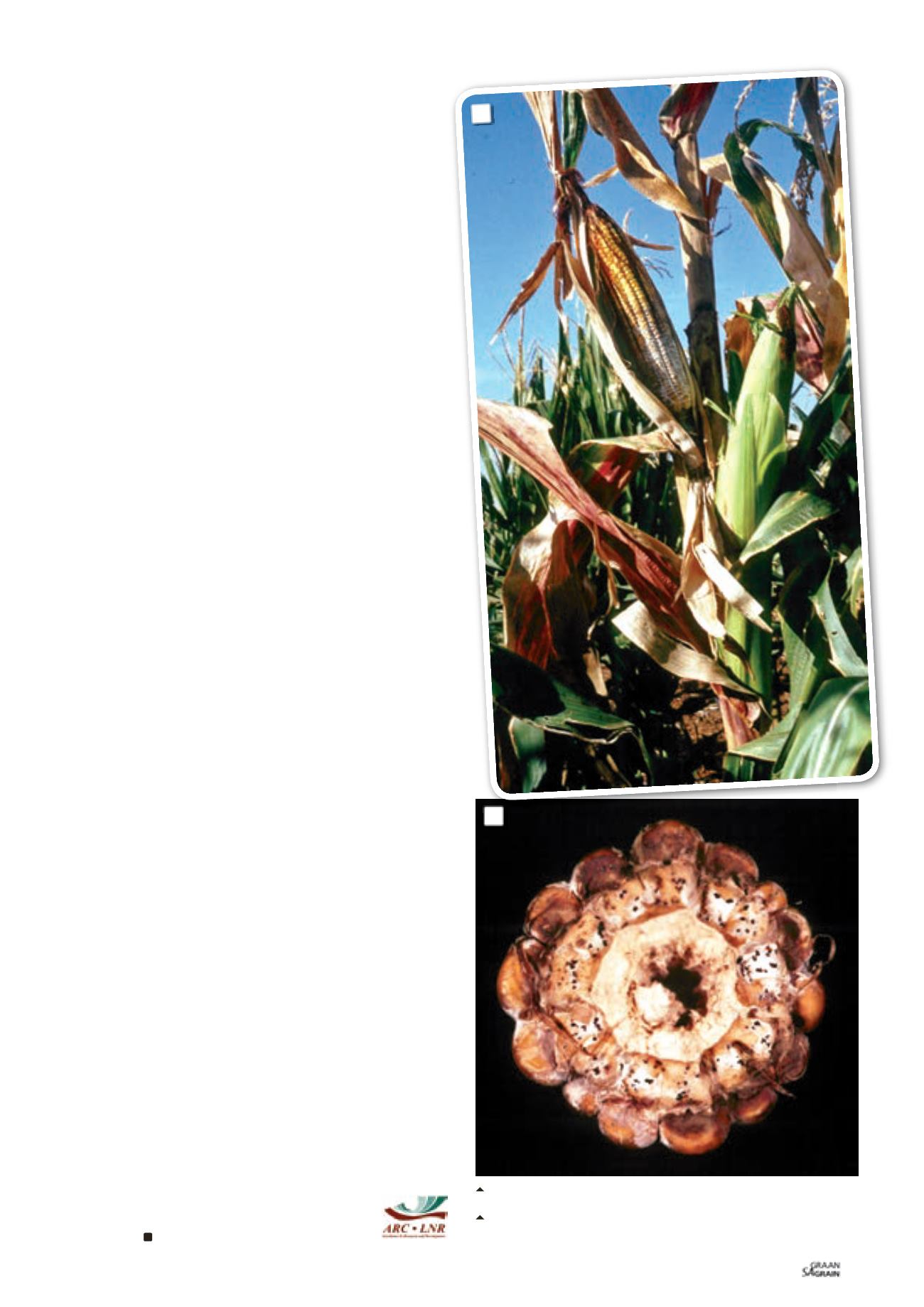
97
August 2014
and stalk rots. However, it appears that there is widespread confu-
sion regarding resistance and theuseof resistance.
Four concepts involved in reactions of hybrids todiseases are toler-
ance, resistance, susceptibility and immunity. These all refer to dif-
ferent reactionsof ahybrid toaspecificdisease. Resistancedoesnot
imply that a hybridwill not get a specific disease. This is immunity.
Resistance is a scale that runs from resistant to susceptible, with
varyingdegrees of resistance/susceptibility inbetween.
It is a misconception that resistance implies no disease at all
(immunity). Resistance is relative to other hybrids. For example,
where the mean of all hybrids tested is 30% diplodia ear rot, any
hybridwith less than 30% is resistant and those above 30% are sus-
ceptible. Thismean percentage varies from one season to another,
dependingonweather conditionsand inoculum levels. Duringa sea-
son where the mean ear rot of all hybrids is 5%, the resistant hy-
brid should still be resistant and the susceptible still susceptible
where hybrid reactions are consistent. Thus, resistance/susceptibil-
ity is relative toother hybrids.
This effect is an interaction between the available inoculum, the
host andprevailingweather conditions. Generally speaking, a resist-
ant hybrid will always have less Diplodia ear rot than susceptible
hybrids relative to prevailing conditions. However, there are many
maize hybrids that react consistently over all localities, but there
are some that do not. The local SouthAfricanNational Cultivar Trial
entries are used to screen maize hybrids annually for resistance/
susceptibi-lity toDiplodia ear rots under variousweather and inocu-
lum conditions.
Resistance toDiplodia stalk rot is difficult toquantify as plant stand-
ability or resistance to lodging, does not necessarilymean the stalk
is not infectedwithDiplodia stalk rot. Itmeans that even though the
stalkmaybe infectedwithDiplodia stalk rot, it will not lodge.
This counters Diplodia stalk rot by preventing lodging and is
generally achieved by improving stalk rind thickness. A thicker rind
may still have Diplodia stalk rot which results in the breakdown of
the stalk pith tissue within the rind. Thicker rinds may in the long
term have the unintended effect of actually increasing
Stenocar-
pellamaydis
inoculum as it ismore resistant to decomposition and
may improve survival of the inoculumwhich fromextensive studies
has been shown to survive successfully in intact maize residues,
particularly those retainedon the soil surface. It is therefore impor-
tant that Diplodia stalk rot resistance is seen in the correct context.
Reducing the risk of diplodiosis in rumi-
nants grazing onDiplodia infested fields
There is no antidote for diplodiosis, but risks can be managed by
removing theanimals fromharvested fieldsas soonas the first signs
of diplodiosis appear.Most, if not all, of the affected animals should
recoverwithgoodnursing after removal from the infested fields.
All mouldy maize cobs should be removed from the field and de-
stroyed before the animals are allowed back into the harvested
fields. Integrated control practices discussed above to reduce Dip-
lodia ear and stalk rot epidemics which include the use of resistant
crop varieties and crop rotation, aimed at reducing the levels of
S.maydis
infectionof themaizeplants, shouldbeconsideredaspre-
ventivemeasures for theoutbreak of diplodiosis.
Should any producers observe suspicious symptoms in ruminants
grazing on maize fields and suspect diplodiosis, please contact
the author at 018 299 6362 or at
or Dr Mxolisi
Masango at
from the Toxicology and Eth-
noveterinary Medicine, Food, Feed and Veterinary Public Health
(FFVPH) Programme, Agricultural Research Council-Onderstepoort
Veterinary Institute (ARC-OVI), SouthAfrica.
As we receive confirmed reports, it will be added to
a database to trace confirmed cases of diplodiosis in
SouthAfrica.
3: The first symptoms of Diplodia ear rot are death and drying of ears
while themaizeplant is still green.
4: A cross section of a Diplodia-infected ear often exposes the fruiting
bodies (pycnidia).
3
4


